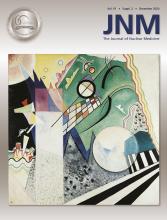An article entitled “In Vivo Imaging of Amyloid Deposition in Alzheimer Disease Using the Radioligand 18F-AV-45 (Florbetapir F 18),” by Wong et al., was published in The Journal of Nuclear Medicine in 2010 (1). It became one of the most-cited publications of this journal from that period. We congratulate the authors for this great achievement.
The tracer 18F-AV-45 was created by Hank Kung’s group at the University of Pennsylvania (2). It was subsequently brought into human testing by Avid Radiopharmaceuticals to noninvasively trace β-amyloid aggregates in the neocortex of patients with Alzheimer disease (AD) by means of PET. The celebrated publication reports on a study designed as a diagnostic phase 2 trial. It was performed in 3 U.S. centers led by Dean Wong’s group at Johns Hopkins. In this study, the brain PET imaging properties, dosimetry, and safety of 18F-AV-45 were investigated. This was done in patients with AD dementia and in healthy controls. The authors reported that the tracer uptake differed between the 2 study participant cohorts, with the uptake pattern in most patients of the AD dementia group nicely resembling what is known about the cerebral β-amyloid plaque accumulation in this disorder. Also, static imaging results correlated well with kinetic modeling outputs. Radiation exposure was found to be in the range of that known for other brain PET tracers. No relevant safety events were observed.
With 11 AD dementia patients and 15 healthy controls entering final data analysis, the cohort size was rather small in this project. The Journal of Nuclear Medicine was probably quite lucky here, as a larger cohort allowing even more clinically relevant questions to be addressed (such as the power of the tracer to discriminate between subgroups) would certainly have attracted higher-ranked neurology journals to publish this paper. However, the convincing study results presented by Wong et al. (1) opened the door for the scientists and sponsor to push the tracer into a phase 3 clinical trial. In this trial, in vivo 18F-AV-45 PET data were intraindividually compared with postmortem histopathology, again with convincing success (3). This pivotal trial finally paved the way to Food and Drug Administration approval in 2012 of 18F-AV-45, or 18F-florbetapir, under the trade name Amyvid (Eli Lilly)—the first amyloid PET tracer ever approved for use as a diagnostic tool for AD.
The publication by Wong et al. (1) also drew attention to the fact that not all patients with the clinical diagnosis of AD dementia are amyloid-positive. This observation was replicated by several other amyloid PET publications. It significantly impacted our thinking on how recruitment into drug-testing trials on AD should be performed in the future, namely by complementing clinical testing with AD biomarkers.
The publication by Wong et al. (1) provided an important chapter in the success story of 18F-AV-45: it created positive evidence for how to apply the tracer in clinical routine in the clinical target population. As this publication sometimes stands in the shadow of the decisive phase 3 study, the impact of this publication has not always been fully appreciated. So, today is the day!
Following the example of 18F-florbetapir, two other 18F-labeled amyloid PET tracers, namely 18F-florbetaben and 18F-flutemetamol, were approved to detect or exclude β-amyloid plaques in the brain. For all these approved amyloid tracers, the nuclear medicine doctors who intend to use them are required to undergo reader training. Further, there are appropriate-use criteria available for these tracers. All these measures guarantee optimal use and utility of amyloid imaging (4). However, a decision on cost reimbursement is still the last remaining milestone to pass in providing amyloid imaging in standard clinical care. It is hoped that the IDEAS study (Imaging Dementia—Evidence for Amyloid Scanning) (5) can provide the missing evidence on the outcome effect of amyloid PET in the target clinical population. The future of amyloid imaging will also depend on the question of whether we will see a disease-modifying drug to successfully treat AD. Then at last will 18F-florbetapir and the other amyloid tracers become true winners in the fight against AD.
DISCLOSURE
No potential conflict of interest relevant to this article was reported.
- © 2020 by the Society of Nuclear Medicine and Molecular Imaging.
REFERENCES
- Received for publication June 18, 2020.
- Accepted for publication August 19, 2020.







